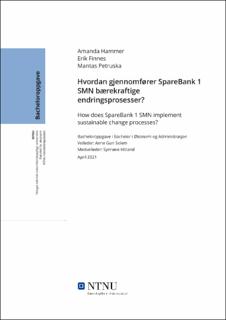| dc.contributor.advisor | Solem, Anne Guri | |
| dc.contributor.advisor | Hitland, Synnøve | |
| dc.contributor.author | Hammer, Amanda | |
| dc.contributor.author | Finnes, Erik | |
| dc.contributor.author | Petruska, Mantas | |
| dc.date.accessioned | 2021-09-14T17:18:23Z | |
| dc.date.available | 2021-09-14T17:18:23Z | |
| dc.date.issued | 2021 | |
| dc.identifier | no.ntnu:inspera:80204379:80756315 | |
| dc.identifier.uri | https://hdl.handle.net/11250/2777248 | |
| dc.description.abstract | Bærekraftig utvikling er et samfunnsmål kommet for å bli. Det har vært stort fokus på bærekraft for nasjoner og for enkeltindivider, ved plastreduksjon og klimaavtaler. FN har vært førende for denne prosessen. Nå har det grønne skiftet også kommet til bank og finanssektoren. FN og EU satser for fullt på sine initiativer om ansvarlig bankdrift og bærekraftig finans. Dette vil få ringvirkninger både i sektoren, og for alle andre deler av samfunnet. Da er det viktig at norske banker også henger med og bidrar i utviklingen.
Denne oppgaven tar for seg tematikken rundt hvordan organisasjoner i finans og banksektoren tar for seg endringsprosesser knyttet til det grønne skiftet. Denne oppgaven har blitt skrevet ved hjelp av deltakere fra SpareBank 1 SMN. Oppgaven er et casestudie, hvor et utvalg av respondenter fra SpareBank 1 SMN har bidratt til å belyse problemstillingen. Problemstillingen i oppgaven er:
“Hvordan gjennomfører SpareBank 1 SMN bærekraftige endringsprosesser?”
Den metodiske tilnærmingen i denne oppgaven er basert på å være en kvalitativ studie. Det er gjennomført dybdeintervjuer med et utvalg som er valgt på bakgrunn av snøballmetoden og kompetanse på emnet. Alle i utvalget er respondenter med førstehåndskompetanse da de er ansatte i SpareBank 1 SMN. Det er ikke en oppgave som er ment til å generalisere bærekraftige endringsprosesser, men heller gi en dypere beskrivelse av hva som har forekommet i dette tilfellet.
Funn i studiet tyder på at SpareBank 1 SMN har brukt en hybrid endringsstrategi. SpareBank 1 SMN har hatt fokus på at de ansatte gjennomfører endringene i sine spesifikke arbeidsområder, mens ledelsen har gjennomført endringer i rapportering, systematisering og struktur av virksomheten. Banken har et verdigrunnlag som påser at bærekraft er integrert i hele forretningen, der definisjonen av bærekraft kommer fra FN og EU sine retningslinjer. Funn i studiet tyder på at denne prosessen ikke har skapt endringskynisme hos de ansatte. Banken har også gode resultater hittil i denne prosessen, både ut i fra et klima-, sosialt og økonomisk perspektiv. | |
| dc.description.abstract | Sustainable development is a societal goal that has come to stay. There has been a major focus on sustainability for both nations and individuals, through measures for plastic reduction and climate deals. The UN has been a guiding force in this process. The green shift has now reached the bank and financing sector. The UN and EU are going all in on their initiatives on responsible banking and sustainable finance. This will create repercussions in both the abovementioned section and society in general. Knowing this it is important that Norwegian banks keep up with and contribute to the developing process.
This thesis discusses the thematic of how organisations in the bank and financing sector enforce the change processes related to the green shift. This thesis has been written with the help of employees of SpareBank 1 SMN. The thesis is a case study; a selection of respondents from SpareBank 1 SMN have contributed to enlighten the research question. The research question for our thesis is:
“How does SpareBank 1 SMN implement sustainable change processes?”
The methodical approach to the thesis is that of qualitative research. We have completed in-depth interviews with a selection based on the snowball method and other relevant knowledge. Every individual in our selection are respondents with first-hand knowledge on the subject at hand, seeing as they are all employed at SpareBank 1 SMN. It is important to stress that the thesis should not be used as a mean to generalise theory on sustainable change processes, but rather give the reader a deeper insight on the sustainable change processes in this particular case.
Findings in the study indicate that SpareBank 1 SMN have used a hybrid change strategy. During the change process, SpareBank 1 SMN focused on having the employees carry out changes in their specific work areas, while the leadership have focused on implementing changes in reporting, systematization and structure of the business. The bank has a set of values that ensures that sustainability is integrated throughout the whole business, and the definition of sustainability is based on UN and EU’s guidelines. Our study indicates that the change process has not created change cynicism among the employees. SpareBank 1 SMN has also achieved positive results during this process seen from a climate, social and economic perspective. | |
| dc.language | nob | |
| dc.publisher | NTNU | |
| dc.title | Hvordan gjennomfører SpareBank 1 SMN bærekraftige endringsprosesser? | |
| dc.type | Bachelor thesis | |
